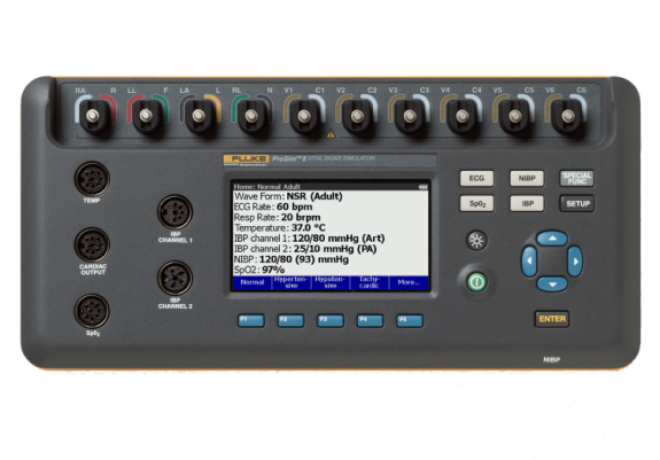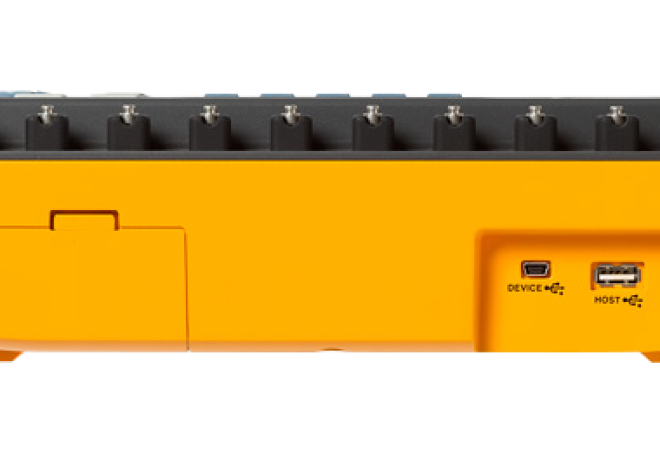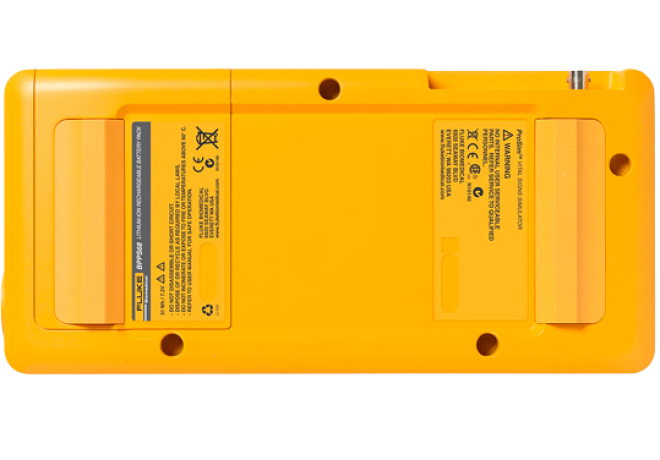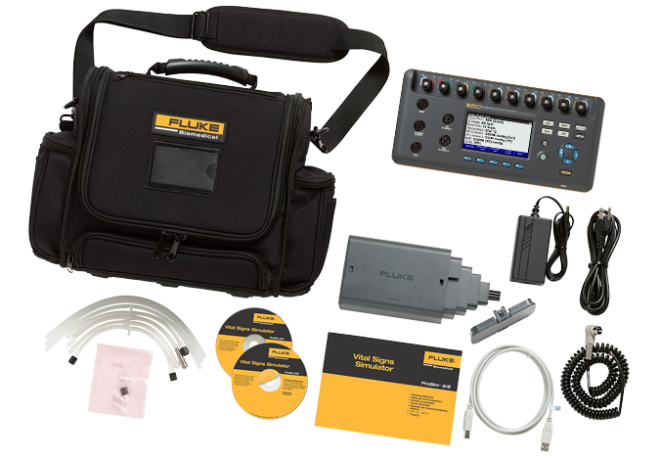



ProSim 8 Vital Signs and ECG Patient Simulator
The industry-leading ProSim 8 patient simulator enables you to complete preventive maintenance testing with one device in less than five minutes, reducing average test time by up to 88%. The ProSim 8 patient simulator is also ideal for design engineers looking for a known physiological signal output.
ProSim 8 Vital Signs and ECG Patient Simulator
Get the all-in-one multifunction vital signs simulator to ensure your devices provide the ultimate in-patient safety.
Designed to make comprehensive patient monitor testing fast and easy, ProSim 8 vital signs simulator offers total patient monitor quality and safety testing from non-invasive blood pressure (NIBP) static pressure linearity and dynamic pressure repeatability tests, EC13 and ACLS ECG waveforms, to complete Nellcor and Nonin SpO2 low perfusion and Masimo Rainbow SET. Featuring specialized stay-connected ECG posts to ensure secure lead connections, ProSim 8 is the preferred tester for patient monitor quality assurance and safety professionals. The ProSim 8 tests ECG (including fetal ECG/IUP and arrhythmias), respiration, temperature, IBP/cardiac catheterization, cardiac output, NIBP, and SpO2 (including Masimo multi-wavelength Rainbow SET)s in a single 5-minute PM testing tool. Wireless PC communication, customized presets, auto-sequences, barcode scanning, onboard memory, direct data capture, printing functions and single-step adjustability maximizes testing productivity; a customized carry case doubles as a mobile workstation. The Fluke Biomedical ProSim line of patient monitor testers are compatible with patient monitors by original equipment manufacturers such as: * GE Healthcare, Philips Healthcare, Spacelabs Healthcare, Nihon Kohden, Welch Allyn, and Draeger (Dräger). * Brand and trade names remain the property of their respective owners. Usage does not imply an endorsement. Multi-language user interface available in English, Spanish, German, French, Japanese, Italian, and Chinese.
Key Features
- All-in-one patient simulator 80% smaller and 17 lbs./7.7 kilos lighter than single function simulator test tools
- 8-in-1 multifunction patient simulator is a combination ECG simulator, fetal simulator, arrhythmia simulator, respiration simulator, temperature simulator, IBP simulator, cardiac output simulator, cardiac catheterization simulator, NIBP simulator and is the premier SpO2 simulator to test Rainbow multi-wavelength waveforms (with optional ProSim SpO2 Test Module)
- Stay-connected ECG posts for easy/secure ECG snap and lead connections
- Custom SpO2 R-curve for accurate testing of the latest and future oximetry technologies
- Static pressure linearity testing
- Repeatable NIBP simulation for dynamic pressure repeatability testing
- Physiologically synchronized pulses across all parameters
- Barcode scanning and direct data capture and printing functionality
- Onboard, customizable patient pre-sets and auto sequences for fast/easy testing
- Multi-language user interface offers choice of language selection
- Integrated, easily-replaceable long-life battery
- Optional PC-interface software offers customizable procedures/checklists and automated data capture/storage
- Wireless communication for remote PC control of test device, as well as data transfer and automated regulatory reporting
| Model Name | Part Number | Description |
|---|---|---|
| ProSim 8 | 3979409 | ProSim 8 Vital Signs Simulator US Includes: USA Ansur demo CD-ROM |
| ProSim 8-01 | 3979411 | ProSim 8 Vital Signs Simulator Schuko Includes: Schuko Ansure Demo CD-ROM |
| ProSim 8-02 | 3979427 | ProSim 8 Vital Signs Simulator UK Includes: UK Ansur demo CD-ROM |
| ProSim 8-03 | 397943 | ProSim 8 Vital Signs Simulator Japan Includes: Japan Ansur demo CD-ROM |
| ProSim 8-04 | 3979448 | ProSim 8 Vital Signs Simulator Australia Includes: Australia Ansur demo CD-ROM |
| ProSim 8-05 | 3979453 | ProSim 8 Vital Signs Simulator Brazil Includes: Brazil Ansur demo CD-ROM |
| ProSim SPOT | 3985658 | ProSim SpO2 Test Module |
| ProSim RAINBOW | 4034609 | ProSim RAINBOW Test CABLE |
Yes, you can edit factory autosequence. Open the factory autosequence, change the test elements, modify the custom settings and click save as button to save it as custom autosequence under different name. However, you cannot overwrite the factory autosequences present in the Ansur Test Library and in the main unit.
a) Step can have following test elements under it
i. Any one test element from the ECG Simulation Test group
ii. Respiration Simulation Test
iii. Temperature Simulation Test
iv. Any one of IBP Dynamic Simulation or IBP Static pressure test from the IBP Simulation Test
group
&nnbsp;v. Only NIBP Dynamic Simulation test from the NIBP Test group
vi. SpO2 test
b) If you include test elements other than the above, Ansur displays a message box and discards those test elements
Firmware update to ProSim 8 can be done ONLY through USB cable.
You can execute factory autosequences in 2 ways
a) 1st way: Open a factory template from the Ansur template library. Click play button from Ansur toolbar and click Start button from the testguide
b) 2nd way: Open Ansur Mini Plug-In. Click Autosequence tab. Select any autosequence from the list. Click Play button. Click start button from the testguide
ProSim 8 can hold up to 100,000 Test IDs (different DUTs) and at least 250,000 test records total. Depending on test procedures, some test records may have more data than others. The saved test records can be wirelessly transferred from a ProSim 8 to a PC by using ProSim 8 Ansur Mini Plug-in.
a) End users are able to customize autosequences and presets by using Ansur ProSim 8 Mini Plug-In which comes along with Ansur executive version 2.9.6. Default autosequences and presets are available in Ansur ProSim library after installing Ansur ProSim 6/8 Plug-In.
b) Pre-sets values can be replaced and restored to default values by using ProSim 8 Ansur Mini Plug-in.
c) End users are able to make their customized autosequences by using ProSim 8 Ansur Mini Plug-in and save them in the ProSim 8. The default autosequences cannot be replaced.
a) The total duration of the execution of the step is the sum of the duration set in each test elements under the step
b) If any one of the duration is set as indefinite then the step execution will be continuous until Next button or Stop button is clicked.
Execution of tests in serial allows the user to simulate waveforms individually, and ProSim device resets to LOCAL mode at completion of each test
b) Execution of the tests in parallel allows user to simulate tests simultaneously, and ProSim device resets to LOCAL mode only at the completion of each Step
a) If you want to execute tests sequentially one by one and enter the results individually and navigate to next test element manually then, drag and drop the test elements into the template without autosequence container
b) If you want to execute tests sequentially one by one and enter the results individually and navigate to next test element automatically then, drag and drop the test elements into the template under the autosequence container
c) If you want to execute tests in parallel at the same time and enter the results after each step then, drag and drop the appropriate test elements under the step
To find the ProSim 8 Ansur mini plug-in instruction:
- Download both latest Ansur Executive and ProSim 8 Ansur plug-in software versions from www.flukebiomedical.com website to your PC.
- From your PC, select START: ALL PROGRAMS, then select the FLUKE tab.
- Both the Ansur Executive and ProSim 8 Ansur plug-in user manual can be found under ANSUR HELP.
- The mini plug-in can be used to create and edit auto sequences, presets and r-curves and upgrade future new firmware. Detailed instruction is in the ProSim 8 Ansur plug-in user manual.
The edit box is locked and is read only. If you wish to enter/edit any value, drag the slider bar or use the LEFT "?" and RIGHT "?" arrows on your keyboard to set the desired value.
Ansur ProSim 8 mini Plug-In requires administrator privileges to run properly. If you have not logged on to your PC as administrator, press the SHIFT key on the keyboard while right-clicking on the Ansur shortcut or ProSim 8 mini Plug-In shortcut on the desktop or Start Menu, then select "run as" administrator. You will now be able to run Ansur ProSim Mini Plug-In without any errors.
ProSim 4 and 8 batteries must be charged using the model-specific battery eliminator shipped with each device. For this reason Fluke Biomedical has:
- Made clear mention of it in the user manuals.
- Added a colored flag to the battery charger (ProSim 4 = yellow label, ProSim 8 = red label).
- Designed electrical protection from possible burn-out from application of the wrong battery charger. Please keep in mind: though this protection is in place, using the wrong battery charger can cause loss of some battery life if connected to the wrong voltage for extended periods of time.
For optimum shelf life in consideration of practicality, we suggest keeping the battery at 30 % to 50 % state-of-charge. There is a non-recoverable capacity loss upon aging. The higher the state of charge & temperature, the higher the percentage of non-recoverable capacity lost. We estimate a 100 % state-of-charge under 25 °C room temperature will have about 15 % capacity loss per year of storage
We suggest you keep the battery pack charge level between 30 % to 50 % state-of-charge for long-term storage. For typical usage it is still more practical to keep the battery fully-charged.
The ProSim power circuits were designed to operate over a specific range of battery voltage levels. As the battery charge is depleted, the battery voltage drops. At a point just above the minimum design voltage for the power supplies, the ProSim will shut itself off. The firmware monitors the battery charge level and warns the customer in advance of this shutdown so that they can respond appropriately (e.g., save date, plug in the charger, swap out the battery pack, etc.).
As long as there is sufficient battery voltage for the ProSim to remain powered on, all circuits will operate normally, even at 0 % charge level. This is because the ProSim doesn't run directly on the battery voltage, because the battery voltage varies and precision circuits need a stable power supply voltage to work properly. The ProSim first converts the variable battery voltage into a stable voltage that doesn't change even when the battery charge level is very low.
There is no specific requirement for this. The risk is lower with lower state-of-charge as the energy level is lower. For practical situations, it doesn't really matter when shipping one or two battery packs at whatever state-of-charge. If the shipment package contains a full box of battery packs, they should be kept at lower state-of-charge, like 30 %.
70 % of the original capacity with operation at 25 °C room temperature.
We don't recommend having the charger connected for a long periods of time. There is a non-recoverable capacity loss upon aging. The higher the state of charge & temperature, the higher the percentage of non-recoverable capacity loss will be. We estimate a 100 % state-of-charge under 25 °C room temperature will have about 15 % capacity loss per year of storage.
Improper cuff size has been considered one of the most common errors with blood pressure measurements. It is well documented that readings can be falsely elevated, sometimes to the extreme with a cuff that is too small. The rule established by the American Heart Association (AHA) suggests cuff width should be at least 40 % of the greatest arm circumference.
Blood pressure is measured with a blood pressure cuff and recorded as two numbers, such as 120/80 mm Hg (millimeters of mercury). The top, larger number is called the systolic pressure. This is the pressure generated when the heart contracts (pumps). It reflects the pressure of the blood against arterial walls. The bottom, smaller number is called the diastolic pressure. This reflects the pressure in the arteries while the heart is filling and resting between heartbeats.
Doctors have determined a normal range for both systolic and diastolic blood pressure after examining the blood pressure of many people. The following figures can be used as a guide for adult blood pressure:
1. Normal blood pressure: less than 120/80 mmHg
2. High/Normal: between 120/80 and 140/90 mmHg
3. High: equal to or more than 140/90 mmHg
4. Very high: equal to or more than 180/110
Individuals whose blood pressure is consistently higher than this norm are said to have high blood pressure, or hypertension. Uncontrolled high blood pressure is indirectly responsible for many deaths and disability resulting from heart attack, stroke, and kidney failure.
Blood pressure can be measured using a variety of techniques, which can be classified into two major categories: invasive and non-invasive. The invasive approach inserts a catheter into an artery of a test subject. The catheter may contain a pressure transducer at its tip or it may be fluid-filled and couple the blood pressure through the fluid to an external transducer. The change of fluid pressure (blood pressure) in the subject's artery is measured invasively. This technique is also referred to as a direct measurement, because the parameter being measured is directly coupled to the transducer. Non-invasive blood pressure measurement usually involves the use of an inflatable cuff wrapped around the limb of a test subject. The cuff is inflated and deflated at a controlled rate and physical parameters are observed. The auscultatory and oscillometric techniques are well known non-invasive methods. These methods are indirect because they do not couple directly to the artery. ProSim 8 and 4 simulates oscillmetric technique since modern NIBP monitors now use oscillometric technique to measure pressure.
The design of the NIBP parameter of a patient monitor is required to be proven to be safe and effective for use in the diagnosis, and treatment of disease states and underlying chronic conditions, and in the prescribing of medications and other therapies. This testing is governed by national and international standards including AAMI/ANSI SP10 and IEC 80601-1-2-30 for minimum performance and safety. The performance of NIBP monitors are required to be evaluated or tested during scheduled maintenance by the manufacturer.
Section 3.4.3 of the ANSI Standard for Electronic or Automated Sphygmomanometers specifies the required efficacy of the blood pressure
determination:
"The mean difference of the paired measurements of the test system and the comparison system shall be ± 5 mmHg or less with a standard deviation of8 mmHg or less."
This means variations in individual readings of 5, 6, or even 10 mmHg are normal and do not indicate either the monitor or the Tester are malfunctioning. Some monitors are more repeatable than others, and repeatability is one measure of the overall quality of the monitor. This is why all NIBP standards only emphasize on dynamic pressure repeatability, not on absolute accuracy.
BP Pump2 and CuffLink has a default pulse volume ranging from 0.5 to 0.75 ml, while ProSim is default at 1 ml. Depending on type of monitors, if you change the pulse volume, cuff size (mandrel blocks) or tubing, the absolute NIBP readings may change accordingly, but repeatability should stay the same.
Each individual manufacturer utilizes their proprietary algorithm for identification of the systolic and diastolic points. Some may use the height of the pressure waveform to mark these points; others may use the slope of the pressure signal. Given that algorithms vary, it is difficult to compare between different blood pressure monitors from different manufacturers.
There are many factors such as tubing, cuff size, and motion, which may affect NIBP readings. This is why all NIBP standards emphasize dynamic pressure repeatability rather than absolute accuracy. BP Pump 2 and CuffLink have a default pulse volume ranging from 0.5 to 0.75ml, while ProSim defaults at 1 ml. Depending on type of monitors, if you change the pulse volume, cuff size (mandrel blocks or 500 ml rigid chamber) or tubing, the absolute NIP readings may change accordingly, but repeatability should stay the same.
The auscultatory technique is based on the sounds caused by the blood flow through the artery that is surrounded by the cuff. These sounds are known as Korotkoff (K) sounds. In manual blood pressure measurement, these sounds are detected by a human observer using a stethoscope.
The oscillometric technique does not use K sounds to determine blood pressure. The oscillometric technique monitors the changes/vibrations in cuff pressure caused by the flow of blood through the artery. The monitor inflates the cuff to a pressure that occludes the artery.
Variability between auscultatory and oscillometric blood pressure readings may be due to many factors including human observer's skill and hearing sensitivity. The main reason an oscillometric reading is typically higher is that the human ear can only pick up sound, not vibrations. Vibrations in the artery occur before any sounds have appeared, so by the time the human ear hears the Korotkoff sounds, systolic may have already occurred.
The more IBP channels a simulator has, the larger and more expensive the simulator will be. The majority of our fleet of customer design partners reported they do not have to use more than two IBP channels at the same time; those who do need to test three or more IBP channels have chosen to test two IBP channels at a time, then two more, and so on. This preference avoids that extra cost, size and weight, and still yields faster/easier testing in the end.
Alternatively, the new ProSim 3 does have four IBP channels thatyou can test all simultaneously.
No. Ensure both ProSim 4 or 8 and patient monitor are properly zeroed before starting the IBP simulation. Below is the step by step procedure on how to properly zero both patient monitor and ProSim 8 for IBP number to display. Please the zero procedure on different patient monitors may be different; please refer to patient monitor user manual for details. The example below uses HP/Philips Viridia vital sign patient monitor:
- Connect ProSim 8 and HP Viridia monitor with proper IBP cables
- Select IBP on ProSim 8, ZERO both IBP channels
- On HP/Viridia, select MODULE SETUP
- Then select PRESS 1 ABP
- Press ZERO XDUCER
- ZERO IN PROCESS should display on the monitor
- Initiate the ProSim 8 IBP simulation. IBP numbers should display on the HP Viridia monitor
The mini B USB Device Port (labeled "Device"underneath the port) is used to connect to a PC for remote control or download test results data to a PC. USB A Controller Port (labeled "Host" underneath the port) is for external keyboard, barcode reader, or printer.
ACLS means Advanced Cardiac Life Support (ACLS). ACLS algorithms includes waveforms from Ventricular Fibrillation, Atria Fibrillation to Complete Heart Block.
After insertion of a Swanz-Ganz catheter into a vein (usually the basilic vein of the forearm), the catheter is gently guided by the flow of the blood into the pulmonary artery. A monitor attached to the distal lumen port supplies a reading of pulmonary-artery pressure (PAP). Pulmonary-capillary-wedge pressure (PCWP) is determined by inflating the balloon, which becomes wedged; when this wedge blocks blood flow, it provides a reading of the pressure in the left side of the heart.
ProSim 4 simulates following 4 parameters:
1) ECG (including normal and Arrhythmias)
2) Respiration
3) IBP (Invasive Blood Pressures)
4) NIBP (Non-Invasive Blood Pressure)
ProSim 8 simulates following 8 parameters:
1) ECG (including normal and Arrhythmias),
2) Respiration
3) IBP (Invasive Blood Pressures)/Cardiac Catheterization
4) Temperature
5) Cardiac Output
6) NIBP (Non-Invasive Blood Pressure)
7) SpO2
8) Masimo Rainbow
Alarm hazards ranks second on the Heath Technology Hazards of 2011. The Boston Globe recently reported the death of a patient whose treatment have been delayed because a critical physiologic monitoring alarm had been turned off.
No, ProSim only does optical testing for SpO2. Fluke Biomedical Index 2 SpO2 Analyser does both electrical and optical SpO2 testing.
